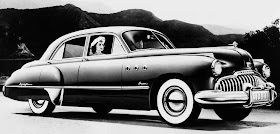Even though he had such preferences, Earl was not a slave to them, particularly the rounded look. After 1935 or thereabouts when the appearance of streamlining became the norm for American automobile style, his GM cars had curves, but there were usually crisp or angular surfaces and details that contrasted or complemented the curved parts.
An interesting example of Earl's styling ideals is the design of the 1949 Buick. I think its styling can be characterized as being a series of curves cascading from the high point of the car's top.
The notion of "cascading curves" is well illustrated in this side view of a Buick Super. Towards the front of the car, a curve descends from the high point of the roof, breaks, and then continues down the windshield. The hood is fairly flat for a ways and then curves downwards, a theme echoed by the front fenderline. To the rear, there is the downwards curve of the top, followed by a similar curve for the trunk lid. What interests me the most is the treatment of the tail lights and aft part of the rear fenders: Note that there is a double set of downward curves here, enhancing the overall cascade theme. The horizontal chrome strip serves as a contrast to the cascading.
Another view of a 1949 Buick Super four-door sedan. More cascading can be found at the front of the hood and the adjoining curves of the vertical grille bars.
A Buick Roadmaster hardtop convertible. Note the cascading elements towards the rear of the car. A set of downward curves flows from the roof to the trunk to the taillights to the aft part of the rear fender.
Rear view of a 1949 Buick Roadmaster four-door sedan. This provides another perspective of the cascading at the rear of the car.
I don't consider the 1949 Buick a great design. But for its era, it is a good one. For some reason, the cascading curves theme has always appealed to me even though I suspect that it is not a good general-purpose design practice. That's because it would usually yield a too-soft appearance. 1949-vintage cars tended to look a little soft anyway, perhaps due to the state of sheet metal stamping practice, so the Buick design theme works well in that context.




No comments:
Post a Comment